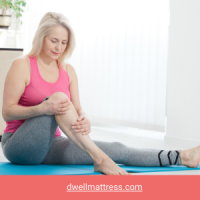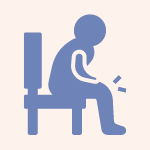People deserve a comfortable night’s sleep, but it doesn’t come easy to everyone. There are many factors that can disrupt a good night’s sleep, and pain is a big factor. For those with arthritis pain, sleep can be nearly impossible.
In this article, we will examine the relationship between arthritis and sleep, and offer some advice on how to sleep with arthritis.

What Is Arthritis?
Arthritis is a joint disorder that causes pain, stiffness, and swelling in the joints. It’s an umbrella term that describes more than 100 rheumatic disorders. Each cause of arthritis may present differently, so it’s important to identify the specific type of arthritis affecting you. The three most common types of arthritis are osteoarthritis, gout, and rheumatoid arthritis. Each has its own signs and symptoms as well as ways to control symptoms and manage your condition over time.
Types Of Arthritis
We cannot detail all the types of arthritis since that would be a huge article! But here’s an overview of the most common types:

1. Osteoarthritis
It is a degenerative form of arthritis that occurs when the cartilage that cushions the ends of bones wears away, leaving bones to rub against each other and cause pain. The knee joint is one of the most common areas of osteoarthritis, but the disease can also manifest throughout the spine or in joints such as the hand.

2. Inflammatory arthritis
Inflammatory arthritis is the most common type of arthritis. It’s an autoimmune disorder, which means something has gone wrong with our bodies’ defense system. It attacks joint tissue, causing inflammation and pain.

3. Infectious arthritis
It is caused by a virus, bacterium or fungus entering the joints, which causes inflammation Metabolic arthritis, a build-up of uric acid causing crystals to form in the joints, causing extreme sharp pains.
Apart from the above Rheumatoid arthritis, psoriatic arthritis, septic arthritis, thumb arthritis, reactive arthritis, juvenile idiopathic arthritis, ankylosing spondylitis, and gout are other types.
More than 50 million adults and 300,000 children in the United States suffer from arthritis. It’s more common in women and older people.
Some more severe types of arthritis can also negatively impact the eyes, heart, kidneys, lungs, and skin.
What Are The Symptoms Of Arthritis?
Due to the variety of types of arthritis, there are a wide range of causes for arthritis.
No matter what type of arthritis you have, chances are you will experience joint pain, swelling, stiffness and even loss of function. These symptoms can initially be relieved with medication but in time it becomes increasingly difficult to manage.
Risk factors for arthritis include:
- A family history of arthritis (genetics)
- Advanced age
- Sex (For instance, women are more likely to develop rheumatoid arthritis, while men are more likely to have gout)
- Joint injury
- Obesity
How Does Arthritis Affect Sleep?
According to the Arthritis Foundation, up to 80% of people with arthritis have difficulty sleeping due to stiffness, pain, achiness, and trouble getting comfortable. This helps explain why fatigue can be a common side effect of arthritis.
Arthritis sufferers might feel best for a few hours after getting up in the morning, when some of the pain and stiffness has faded. As the day wears on though, they will often feel achy and stiff. At night at long last, they can rest for about an hour or two. After that, it’s just one more night spent tossing and turning in pain with no relief in sight.
While people who deal with arthritis are obviously more likely to deal with joint-related pain and stiffness, the condition can also cause “nonspecific” musculoskeletal pain, which may include pain in the back and neck. Nonspecific pains not related to joints are especially common in patients with fibromyalgia and chronic fatigue syndrome.
In fact, a large review found that adults with arthritis are more likely to suffer from insomnia. Joint pain and its associated limitations caused this difficulty sleeping. People with arthritis more likely to suffer from sleep disturbances include those struggling with anxiety or depression. In total, it was found that up to 10.2 million U.S. adults with arthritis suffer from poor quality sleep.
Why Does Arthritis Hurt More At Night?
Sleeping is one area where living with arthritis pain becomes tough because the joints feel stiff and relaxed joints are a prerequisite for a restful sleep. If you are not able to sleep at night, here is some information on some tips that can help you overcome this problem but you must also consult your doctor and follow his advice.
What’s The Best Sleeping Position For Arthritis?

Your chosen sleep position matters because it can influence your ability to get and stay comfortable throughout the night—and finding a comfortable position increases the chances that you’ll sleep well. This is true for everyone, and it’s especially true for people with arthritis—a painful condition that causes swelling or stiffness in a joint or joints.
There is no “best” sleep position for arthritis. Arthritis is a word that describes a group of conditions characterized by joint pain and stiffness. When it comes to sleeping, the ability to get a good night’s rest can be challenging for anyone, with or without arthritis in the joints. While some may say you need to sleep on your side to prevent blood from pooling throughout the night, this isn’t always desirable for those who suffer from chronic pain, as staying in one position can exacerbate aches and pains.
Sleeping positions are affected by pain in the legs or back, and while many factors contribute to pain, sleep position is an important consideration. For instance, people with back pain might find it helpful to sleep on their side with a pillow between the knees, sleep flat on their back, or sleep on their back with a pillow under the knees. Meanwhile, people with knee pain might find that it’s helpful to lie on their sides with a pillow between the knees or sleep on their back with a pillow under the knees.
Sleep specialists don’t recommend sleeping on the stomach because lying flat on our bellies compresses our lungs and prevents proper breathing. But if you simply must sleep face-down, place a pillow under your abdomen for support.
When it comes to choosing your mattress, your number one concern should be spinal alignment. In other words, how your head, neck and spine line up when sleeping on the mattress. If you’re sleeping with a hunched back, or are too upright (like a plank), then…yeah, you guessed it — it’s not going to feel all that great.
How To Sleep With Arthritis?
Investment in a comfortable, supportive mattress tailored for your unique needs is step one in improving your chances of sleeping with arthritis. Beyond that, there are additional steps you can take to help yourself. We also consulted with Dr. Bo Babenko, DPT.
Dr. Babenko recommends that you maintain a routine that includes sound sleep and managing your arthritis symptoms in conjunction with a health coach and/or physiotherapist.
Summary
We hope this article helped you, though we want to emphasize that we are not doctors and work best with a physician through an individualized sleep plan. Everyone deserves a comfortable night’s sleep, so taking some of these tips can help you sleep better.
